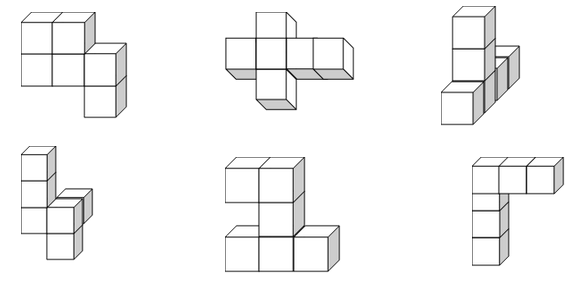You will be engaged in activities related to art in this lesson. The lesson begins with an activity to promote three-dimensional mental imagery. You will analyze and try to replicate by drawing and building.
Objectives
- We will be able to visualize a three-dimensional shape and replicate it.
- We will be able to make a drawing on grid paper of one of Albers’ Bowers artworks.
- We will be able to sketch an Albers Multiplex.
Assessment
- Note students’ competency in building a shape with Snap Cubes.
- Performance Assessment: Look at the quality of the Bowers they make.
Time Required
1 hour
Materials/Resources Needed
- Document camera/projector
- Art images (linked below in the activities)
- Activity pages (1–3)
- Snap cubes (about six per student)
- Pencils
- Colored pencils
North Carolina Curriculum Alignment
Activity One: Snap Cube Symmetry
NOTE: All pages referenced below are linked above in Materials/Resources Needed as “Activity pages.”
- Distribute six snap cubes to each student.
- Make a three-dimensional figure with five Snap Cubes and hold it high so all can see. Ask students to use their snap cubes to replicate yours.
- Have students compare their shape with others. Walk around the room and hold yours near theirs and ask, “Are they the same?”. It is likely that some will make a shape that is symmetric in space like right and left gloves are symmetric. Repeat the activity with a different five-cube shape.
- Now try the same activity a few times with a three-dimensional shape using six cubes. Some possible ways to configure the snap cubes appear below.
On subsequent days, you might want to use two variations of this activity.
Variation I: Each student makes a three-dimensional shape with cubes under the desk so others cannot see it. They pass to another, that person feels it, hands it back, and then makes the shape with cubes on their desk.
Variation II: Students are paired facing each other with a barrier between them. One person makes a three-dimensional shape with cubes and the other must make the shape using only verbal directions given by the person who made the shape.

Activity Two: Bowers
NOTE: Read the artist biography of Josef Albers with your students before you begin the lesson. All pages referenced below are linked above in Materials/Resources Needed as “Activity pages.”
- Project Formulation: Articulation Folio II, Folder 12 (detail) by Josef Albers. This is a design that the artist called a “bowers.” Tell students that Josef Albers created this artwork using a grid and ask students to describe what they see.
- Pass out the Bowers worksheet (activity page 1). Students can record 3 words to describe what they see in this artwork for #1.
- For #2, students will study the detail of the “Bowers” artwork and use a pencil to copy the design onto the blank grid. Indicate to students that they should use their pencils to shade the grey and black spaces to replicate the artwork design.
- After students have finished #2, ask them to look at the artwork being projected and try to identify which segment of the artwork is detailed on their worksheets.
- The same artwork detail is showing in #3. For this problem, students will draw the detail again but this time reversing the black and white spaces. Grey spaces remain the same, white spaces become black, and black spaces become white.
- Using the detail of the artwork on their worksheet, students can answer #4-8. Collect papers or go over answers together as a class.
Activity Three: Optical Illusions
- Project Multiplex B by Josef Albers. Ask students to talk about what they see and discuss whether the figure could exist in three-dimensional space.
FOR TEACHERS ONLY: Albers’ Multiplex B is an optical illusion. It is an “impossible form” and could not exist in three-dimensional space. Each individual’s perception determines how they see the form. - Cover the bottom half of the Multiplex B projection. Ask students to consider how that changes the image.
FOR TEACHERS ONLY: By covering the bottom half of the form, Multiplex B becomes a “possible form,” able to exist in three-dimensional space. - Pass out the Optical Illusions worksheet (activity page 3) and ask students to answer the questions and to try to draw the top half of Multiplex B figure in the space provided.
